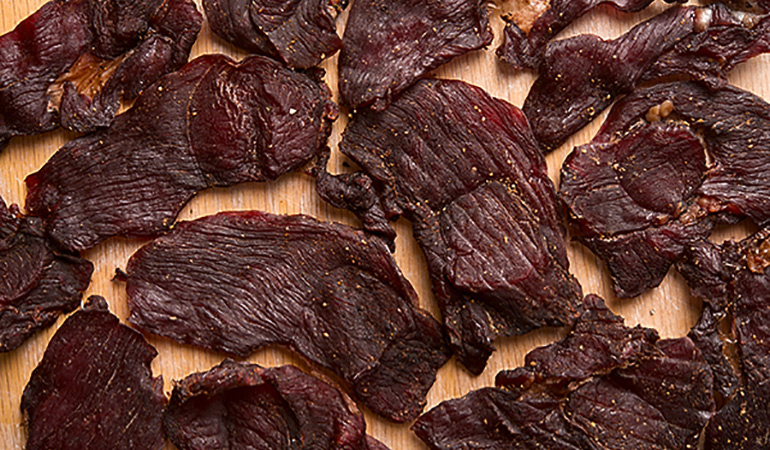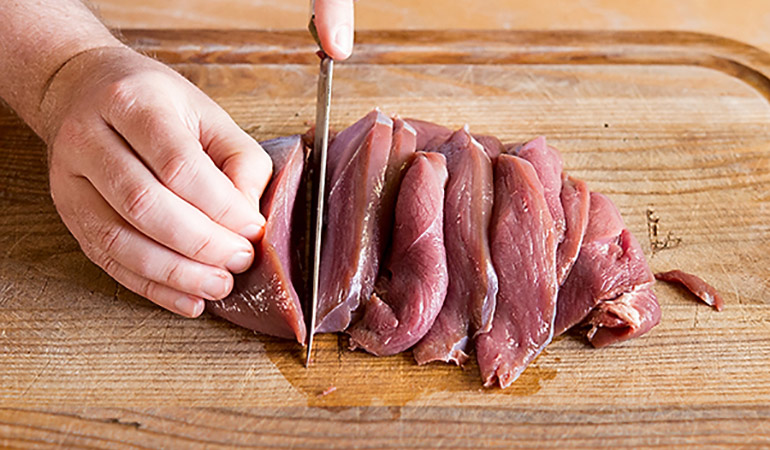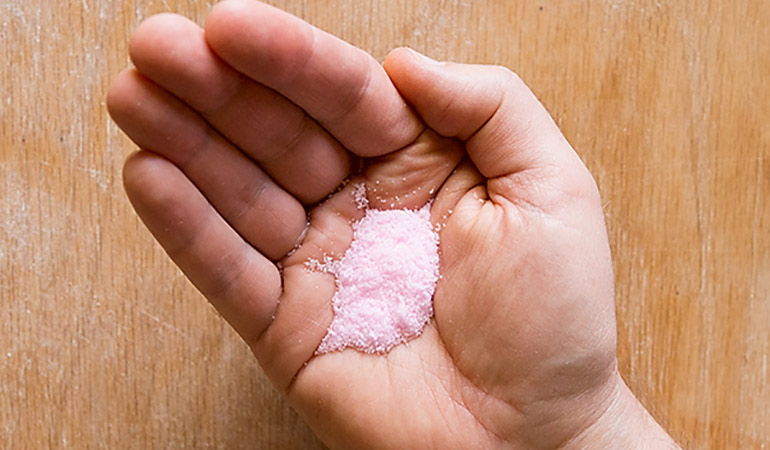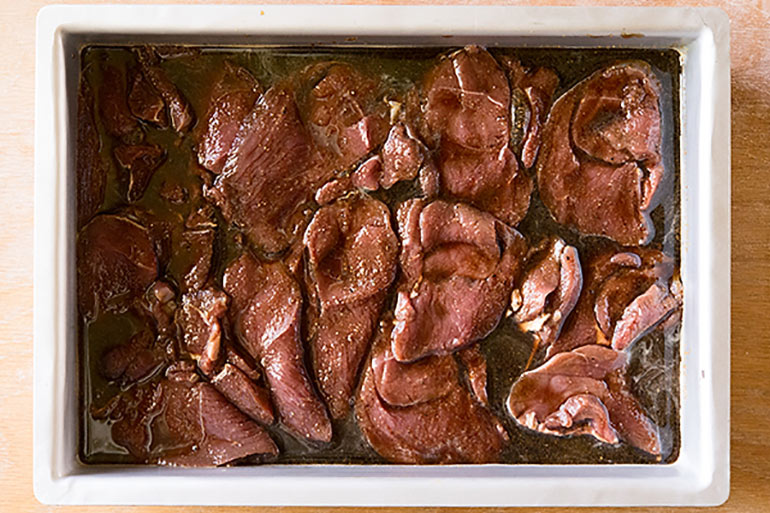
Print Recipe
Jerky is the ultimate travel food. I eat it whenever I’m out in the woods or on the water, driving across the country or hunkering down in a duck blind. And while you can make venison jerky from pretty much anything, venison is the ideal jerky meat – it’s wonderfully lean and loaded with protein. Venison also works great because you can use a big hind leg roast – a perfect candidate for slicing thin, curing and drying – and you get bigger slices that are easier to eat.
There are as many ways to make jerky as there are people who make it. What follows is my personal process for making traditional jerky from whole cuts of venison, not the reconstituted jerky you make with a modified caulking gun. That stuff can be pretty good, but it still freaks me out.
Traditional jerky is both an art and a science. The art is in the flavorings, the cut of meat and how you dry it. The science comes in when you’re dealing with salt, acid, temperature and time. It really isn’t terribly difficult, as long as you follow these guidelines.
Choose the Right Cut

I always use whole roasts from the hind legs of the deer because they hold together well, slice easily and are generally a bit tougher than backstrap, which makes them a better candidate for jerky. Yes, you can use backstrap for jerky, but it seems like a waste to me.
Whatever cut you use, trim as much fat off as you can. Jerky needs to be lean. Meat can dry and cure quite well, but fat left on jerky can go rancid quickly.
Remember, the meat will lose a lot of weight once it’s dried – a four-pound roast will make only about a pound of jerky. The takeaway is simply to make more than you think you need. And don’t worry if you end up with a ton of jerky on your hands; trust me, you’ll eat it.
Say No to Silverskin

Be sure to remove as much of the sinewy silverskin as you can. If you don’t, it’s essentially deer dental floss. Use a thin-bladed, sharp knife to do this, such as a boning knife or a fish filleting knife.
Making the Cut

If you are good with a knife and have sharp blades, you can go ahead and slice your venison in pieces about ¼ inch thick. But if you want a little insurance, freeze the venison for approximately 1 hour first. This will make it stiffer, and much easier to cut into uniform slices.
I find that ¼-inch thick pieces is a sweet spot – too much thicker and you have issues with drying the jerky for long term storage. Too much thinner and it becomes brittle and unpleasantly dry. A cut of about ½ inch thick will still dry pretty well, and will remain nicely chewy when you eat it. The tradeoff is that it doesn’t keep. I make this jerky for specific occasions where I know I will eat it all in a couple days, like a fishing trip.
Build Your Brine

With rare exceptions – like if you live in the Arctic – you need to salt your venison before you make jerky. The best way to do this is to brine it. And this is where your creativity comes in. Your brine provides the dominant flavor of your jerky, whether it’s something like teriyaki or chipotle, or even just a simple salt and pepper brine.
Even when I am not making a straight-up teriyaki jerky, I almost always add soy sauce – it has great flavor and improves the color of the finished jerky. Another staple in jerky making is Worcestershire sauce, which is not only tasty but also adds some needed acidity to the brine. Here is my standard venison jerky brine, for about 3 to 4 pounds of meat.
Brine Ingredients:
- 1 cup water
- ½ cup soy
- ¼ cup Worcestershire sauce
- 1 tablespoon kosher salt
- 3 tablespoons brown sugar
- 1 tablespoon ground black pepper
- 2 teaspoons garlic powder
- ½ teaspoon Instacure No. 1
Salt to Taste

Yes, I know. People have been making jerky without curing salt for a long time. But they have been using it for almost as long. Curing salt, in this case sodium nitrite – sold widely as Instacure or Prague Powder No. 1 – does several things. Most importantly, it kills bacteria such as clostridium botulinum, which can be lethal. Curing salt also improves the color of the venison, gives it that familiar “cured meat” flavor and helps keep any fat you’ve left on the jerky from going rancid too quickly. I always use it.
Soak On That

Mix the brine ingredients well and coat the venison with the brine. Once everything is nicely coated, put it all in a freezer bag in the refrigerator for at least 12 hours, and up to 48 hours. The longer you leave the meat in the brine, the saltier it will be and the longer it will keep.
Dry Your Jerky

The best jerky is dried either in the hot desert sun, or in a dehydrator. Ovens will work, but they generally run too hot. I have some friends in Arizona who dry their jerky in a fine-meshed box outside; the fine mesh keeps the flies off. Most of us in milder climes use a dehydrator, however.
You should know that the USDA says to dehydrate your jerky at 160 degrees. That’s way too hot for me. I dry my venison jerky at about 145 degrees. I can get away with this because I use the Instacure No. 1, which protects the meat at lower temperatures. What’s the difference? You get a rosier color and a more deeply flavored jerky with lower temperatures, which means it’s more of a cured taste than a cooked one.
If you use an oven, turn it to its lowest setting and prop the door open. If you have a convection oven, use it – the air circulation will dry the jerky nicely.
You can tell the jerky is ready because it will just begin to crack when you bend it. It should not be brittle. And remember, the jerky will firm up when it cools, so pull it when it seems just a little under-dried. For me, this takes about 7 hours at 145 degrees.
Take, Eat and Enjoy

Quite frankly, I eat my homemade jerky pretty quickly. I put it in a plastic bag and carry it around whenever I am hunting, fishing or foraging. In between I keep it in the fridge, though it is perfectly safe stored at room temperature for a few weeks. Better safe than sorry.
You can also vacuum seal your jerky and store it in the fridge for several months. If you don’t seal it, the jerky will get incredibly dry and brittle.












